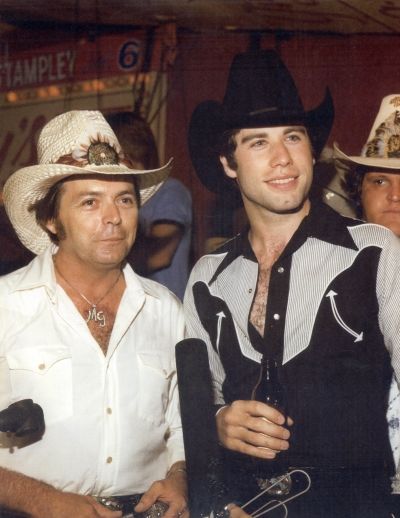By Tyler Wilson
Originally published in Coeur Voice – April 2018
 Singer Mickey Gilley got along just fine before the release of the 1980 John Travolta-Debra Winger film, “Urban Cowboy.” Gilley strung together a series of country hits throughout the 1970s, and he also co-owned Gilley’s, the massive honky-tonk in Pasadena, Texas that popularized the mechanical bull and would eventually serve as the backdrop to the film.
Singer Mickey Gilley got along just fine before the release of the 1980 John Travolta-Debra Winger film, “Urban Cowboy.” Gilley strung together a series of country hits throughout the 1970s, and he also co-owned Gilley’s, the massive honky-tonk in Pasadena, Texas that popularized the mechanical bull and would eventually serve as the backdrop to the film.
“When we first signed off for them to use the club, I still had the feeling that it wouldn’t happen. Then here came these Paramount trucks rolling into the parking lot,” Gilley said in a phone interview with the Press. “It was the most unbelievable thing. The movie launched us into the stratosphere.”
Adapted from an Esquire Magazine article about a romance between two real-life Gilley’s regulars, “Urban Cowboy” was a modest box office success – it grossed $53 million in the United States, considerably less than Travolta’s first two mega-hits, “Saturday Night Fever” and “Grease.”
But the music became a phenomenon, catapulting country music into popular culture. Gilley’s cover of “Stand By Me” was just one breakout hit, and Gilley’s career surged on both the country and pop charts. Gilley would eventually perform for two presidents, and, even now at age 82, he still fills concert houses with diverse generations of fans.
To this day, Gilley credits Travolta for starting the craze.
“If anybody but John Travolta had done it at the time, it probably wouldn’t have had the kind of impact it had,” Gilley said. “They keep running the film on television, and it seems like it just keeps coming back around.”
Singer Johnny Lee, who also appeared in the film, saw his song “Lookin’ for Love” reach #1 on the country charts and made the top five on the Billboard Hot 100 chart.
“It just caught on, man,” Lee said about the film in an interview with the Press. “The music was great, and it changed country music. Everybody was wearing the boots and the hats. People had Gilley’s hats… it’s still going on. I had an 8-year-old girl recently get on stage with me and she knew all the words to ‘Lookin’ for Love.’”
One of the most iconic elements of the “Urban Cowboy” boom was the mechanical bull, something that Gilley said almost never made it into the club in the first place.
“When (co-owner Sherwood Cryer) first put the mechanical bull into the club, I thought it was a mistake, because it was a rodeo-training device. It was never designed to be an entertainment product,” Gilley said. “I knew people would get hurt, and they did. We had lots of lawsuits, even when they signed a release, they still sued.”
Both Gilley and Lee recalled the production cast and crew to be kind and professional, though the shoot wasn’t without drawbacks.
“My business partner wouldn’t let them use the club at night… he wanted the club open at night. Most of the filming was done during the day with black curtains over the doors,” Gilley said.
“I remember it was hotter than Hades,” Lee said. They had to turn the air conditioning off because of the noise. It was June and July, and it was real hot.”
Even after production ended, it was unclear if anything would really change once the movie made it to theaters.
“I figured it would either help our careers or it would blow us out of the water and set us back,” Lee said.
“Urban Cowboy” catapulted the careers of Gilley, Lee and others, and Gilley’s Club attracted mobs of people for years. But Gilley said he and his business partner didn’t share the same standards when it came to keeping the place in working order. The club eventually closed in 1989, and in 1990, a fire gutted destroyed much of the building.
Gilley’s would eventually return -a new club opened in 2003 in Dallas, with a 26,000-square-foot showroom and the original mechanical bull featured in the movie. Other Gilley’s Clubs have also popped up across the country.
Lee and Gilley have worked together on and off for decades – they currently play together often in their hometown of Branson, Mo., at Gilley’s Shanghai Theater. Now the pair co-headline the “Urban Cowboy Reunion Tour” with stops all across the country in 2018.
The show features a set list of hits from each headliner before Lee and Gilley unite onstage for an epic 20-minute medley of “Urban Cowboy” tunes. The show is stacked with familiar tunes, with close to 30 top country hits between them.
Age hasn’t slowed either performer, though a spinal cord injury in 2009 left Gilley partially paralyzed, preventing him from playing the keyboard.
“I just turned 82, I hope to look like I’m 50, and I’m walking like I’m 90,” Gilley said. “I bet some come out just to see if you’re still alive, but we’ve been having a great time with it.”
“I go out because I feel good about being and stage and working for the people,” he continued. “I do it because I enjoy the camaraderie, and we try to do the songs as close to the recordings as possible.”
Lee said slowing down just isn’t an option for him.
“Ah hell no. I’m not ready to say, ‘Welcome to Wal-Mart,’” Lee said. “People are still coming to see me. I’d be crazy to retire.”
And both still count their blessings on a daily basis.
“Every night I go to bed, I thank John Travolta. Thank you, John, for coming into our life,” Gilley said.
